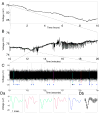Large-scale electrophysiology: acquisition, compression, encryption, and storage of big data
- PMID: 19427545
- PMCID: PMC2720128
- DOI: 10.1016/j.jneumeth.2009.03.022
Large-scale electrophysiology: acquisition, compression, encryption, and storage of big data
Abstract
The use of large-scale electrophysiology to obtain high spatiotemporal resolution brain recordings (>100 channels) capable of probing the range of neural activity from local field potential oscillations to single-neuron action potentials presents new challenges for data acquisition, storage, and analysis. Our group is currently performing continuous, long-term electrophysiological recordings in human subjects undergoing evaluation for epilepsy surgery using hybrid intracranial electrodes composed of up to 320 micro- and clinical macroelectrode arrays. DC-capable amplifiers, sampling at 32kHz per channel with 18-bits of A/D resolution are capable of resolving extracellular voltages spanning single-neuron action potentials, high frequency oscillations, and high amplitude ultra-slow activity, but this approach generates 3 terabytes of data per day (at 4 bytes per sample) using current data formats. Data compression can provide several practical benefits, but only if data can be compressed and appended to files in real-time in a format that allows random access to data segments of varying size. Here we describe a state-of-the-art, scalable, electrophysiology platform designed for acquisition, compression, encryption, and storage of large-scale data. Data are stored in a file format that incorporates lossless data compression using range-encoded differences, a 32-bit cyclically redundant checksum to ensure data integrity, and 128-bit encryption for protection of patient information.
Figures









References
-
- Antoniol G, Tonella P. EEG data compression techniques. IEEE Transactions on Biomedical Engineering. 1997 Feb;44(2):105–14. - PubMed
-
- Bodden E, Clasen M, Kneis J. Proseminar Datenkompression 2001. University of Technology Aachen; 2002. Arithmetic Coding in a nutshell.
-
- Bower MR, Buckmaster PS. Changes in granule cell firing rates precede locally recorded spontaneous seizures by minutes in an animal model of temporal lobe epilepsy. J Neurophysiol. 2008 May;99(5):2431–42. - PubMed
-
- Buzsaki G. Large-scale recording of neural ensembles. Nat Neurosci. 2004 May;7(5):446–51. - PubMed
Publication types
MeSH terms
Grants and funding
LinkOut - more resources
Full Text Sources
Other Literature Sources

